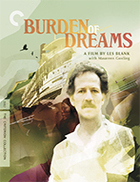Burden of Dreams (4K UHD)
|  Documentaries and television programs about the making of movies are so common today that they have become banal. Home video releases have been including featurettes about the various aspects of the film’s production for decades (at least since The Criterion Collection pioneered the concept on laserdisc in the mid-1980s), and online and streaming specials routinely take us “behind the scenes” to see the making of the next Hollywood blockbuster. Of course, as most savvy filmgoers know, the vast majority of such programs are purely commercial in nature, with the primary goal being to sell a product, rather than to inform. This is borne out in the upbeat nature of such programs, with directors, writers, and actors waxing poetic about how “great” it was to work with so-and-so and behind-the-scenes footage that paints a portrait of orderly artistic professionalism and efficiency. Les Blank’s Burden of Dreams, a behind-the-scenes documentary that was shot throughout the tortured production of Werner Herzog’s Fitzcarraldo (1982), is another beast altogether. Like Hearts of Darkness: A Filmmaker’s Apocalypse (1991), Fax Bahr and George Hickenlooper’s scintillating exploration of the pain and absurdity required to bring Francis Ford Coppola’s magnum opus Apocalypse Now (1979) to the screen, Burden of Dreams is a portrait of filmmaking as a dangerous, potentially deadly obsession, even in the face of nearly insurmountable obstacles. Amazingly enough, despite all the turmoil, chaos, and unforeseen disasters, Herzog comes across as strangely in control throughout the film. A darling of the New German Cinema movement of the 1970s, Herzog was a renowned cinematic madman who didn’t mind shooting on an active volcano and was rumored to have pulled a gun on Klaus Kinski during the production of Aguirre, the Wrath of God (1972) to get the performance he wanted. However, even as the production of Fitzcarraldo seems to be imploding around him, he shows only a few signs of brittle frustration or outright anger. Granted, he is disposed to making rather extraordinary claims, such as when he declares that the jungle is evil or when he says that he will either live by Fitzcarraldo or end his life by it. Part of Herzog’s strange charm is that he makes such bold statements with a kind of blunt matter-of-factness that is, in its own way, both extraordinarily demented and invigorating. This is a man who knows what he wants and will not let anything stand in the way. Herzog began shooting Fitzcarraldo in 1979 in the remote jungles of South America, with Jason Robards and Mick Jagger in the two lead roles. Robards was to play the title character, a man who was obsessed with building an opera house in the Amazonian rainforst (it is not surprising that so many of Herzog’s characters are obsessive). Problems arise from the outset, when the production becomes ensnarled in a dispute between indigenous tribes, and they are forced to desert their initial location and find another one 1,500 miles away. Almost a year later, with new locations established, production resumes; however, with 40% of the film in the can, Robards becomes deathly ill, returns to the United States, and is forbidden by his doctor from returning. Meanwhile, Mick Jagger must also leave the production to fulfill his commitment to a Rolling Stones tour. Thus, all the footage goes into the garbage and Herzog must start all over again, this time with a new leading man, the brilliant, but notoriously intemperate German actor Klaus Kinski (with whom he had worked on three previous films). That was hardly the end of the problems, however. At one point, several of the local crewmembers were attacked by a neighboring tribe, and the camera later shows us the jagged scar on a man who was shot through the neck with a spear. The central setpiece of both Fitzcarraldo and Burden of Dreams is a sequence in which a 130-ton iron steamship is literally dragged over a muddy hill from one river to another. The dragging of this steamship is a perfect metaphor for Herzog’s brutal filmmaking regimen, which required as much actuality as possible. Refusing to use models, special effects, or even a ship made of lighter materials, Herzog insisted that the actual iron ship be dragged up an actual hill in the middle of an actual jungle in the remote environs of South America. The entire enterprise was deemed too dangerous by the Brazilian engineer who designed the mechanisms by which the ship would be dragged, and he walked off the production. In an interview, the engineer says quite frankly that there’s a 70% chance that something disastrous will happen. Director Les Blank, who followed Herzog throughout the production, captures a wide range of moods and situations. While a large portion of the film is made up of talking-head interviews (most of which are with Herzog, who is such a fascinating screen presence that you almost wish he had gone through with his idea to play Fitzcarraldo himself), Blank’s camera tends to wander to the margins, focusing in on the insect life, or the locals making food, or a soccer game. He gives the film a great sense of texture and a lived-in feel; it’s not very long, but the pointed selection of footage and combination of production and context makes it feel as if it’s being laid out on a much larger canvas. There are some definite omissions, most notably almost any instances of Kinski’s infamous temper tantrums (which were filmed and show up in Herzog’s 1999 documentary My Best Fiend). However, whatever is left outside the margins is made up for with the fascinating stuff we do see on screen, which unlike so many making-of documentaries we see today, shows us both the joys and the pains of bringing a labor of love to life.
Copyright © 2025 James Kendrick Thoughts? E-mail James Kendrick All images copyright © The Criterion Collection | |||||||||||||||||||||||||||||
Overall Rating: 


 (3.5)
(3.5)


